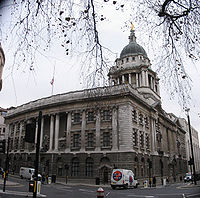
Edward William Mountford
Encyclopedia

Architect
An architect is a person trained in the planning, design and oversight of the construction of buildings. To practice architecture means to offer or render services in connection with the design and construction of a building, or group of buildings and the space within the site surrounding the...
, noted for his Edwardian Baroque
Edwardian Baroque architecture
The term Edwardian Baroque refers to the Neo-Baroque architectural style of many public buildings built in the British Empire during the Edwardian era ....
style, who designed the Old Bailey
Old Bailey
The Central Criminal Court in England and Wales, commonly known as the Old Bailey from the street in which it stands, is a court building in central London, one of a number of buildings housing the Crown Court...
.
Life
He was born in Shipston-on-StourShipston-on-Stour
Shipston-on-Stour is a town and civil parish on the River Stour about south of Stratford-upon-Avon in Warwickshire. It is in the northern part of the Cotswolds, close to the boundaries with Oxfordshire and Gloucestershire....
, Worcestershire
Worcestershire
Worcestershire is a non-metropolitan county, established in antiquity, located in the West Midlands region of England. For Eurostat purposes it is a NUTS 3 region and is one of three counties that comprise the "Herefordshire, Worcestershire and Warwickshire" NUTS 2 region...
and was educated privately. He married twice, to Jessie Smith (18 June 1888) and, following her death, Dorothy Hounsham (11 July 1903). He had a son (who became an architect) from his first marriage, and a daughter from his second. He died in London on 7 February 1908.
He was a Fellow of the Royal Institute of British Architects
Royal Institute of British Architects
The Royal Institute of British Architects is a professional body for architects primarily in the United Kingdom, but also internationally.-History:...
, and President of the Architectural Association.
Notable Buildings
- Sheffield Town HallSheffield Town HallSheffield Town Hall is a building in the City of Sheffield, England. The building is used by Sheffield City Council, and also contains a publicly displayed collection of silverware. The current building, Sheffield's fourth town hall, is located on Pinstone Street. It was designed by the...
1890 - Battersea Town HallBattersea Arts CentreThe Battersea Arts Centre is a performance space near Clapham Junction in Battersea, in the London Borough of Wandsworth that specialises in music and theatre productions.-History:...
1892 - St Olave's Grammar SchoolSt Olave's Grammar SchoolSt Olave's and St Saviour's Grammar School is a super-selective boys' secondary school in Orpington, Greater London, England. The school is consistently one of the top achieving state schools in the UK and it was The Sunday Times State School of the Year in 2008...
1893 - Northampton InstituteCity University, LondonCity University London , is a public research university located in London, United Kingdom. It was founded in 1894 as the Northampton Institute and became a university in 1966, when it adopted its present name....
1896 - Old BaileyOld BaileyThe Central Criminal Court in England and Wales, commonly known as the Old Bailey from the street in which it stands, is a court building in central London, one of a number of buildings housing the Crown Court...
1900-1907 - Lancaster Town Hall 1909
- College of Technology and Museum ExtensionCollege of Technology and Museum ExtensionThe College of Technology and Museum Extension Byrom Street, Liverpool, England was built between 1896 and 1901, the architect was Edward William Mountford. The building was constructed to provide a new College of Technology and an extension to the museum...
1896-1909

